
How Coronavirus is Shifting Strategies for Parking Garages
Here’s what to know and some tips for moving into the new normal of parking garage management during the coronavirus pandemic.
Learn from award-winning professionals — explore our whitepapers, blogs, and the latest industry updates.
Join our dynamic organization of engineers, land surveyors, landscape architects, environmental scientists, and architects!
Talk to a market leader today! We’ll answer any questions you have about our professional services.

To access the original article, please click here
Parking has long been a frustrating endeavor in the Texas Medical Center, a nonprofit that operates 20 parking garages and about 28,000 total spaces throughout its sprawling 1,300-acre campus.
Just ask Donna Halaas, a Texas City resident whose husband has been battling cancer and a slew of other health problems, including kidney disease. On Oct. 28, she was accompanying her husband to MD Anderson Cancer Center for radiation treatment, when she was forced to reckon with the parking issue, she said.
“It triggered my anxiety,” Halaas said after winding through six levels of a parking garage, among hundreds of tightly packed cars, to find a space. “I bought myself a chocolate bar because I feel like I deserved it because I didn’t punch anybody.”
Medical center leaders have been slow to take up significant parking garage improvements in the campus’ bustling core – improvements that multiple engineering firms have recommended over the last 10 years to improve traffic and make the parking experience less stressful for visitors.
In a 2014 grant-funded mobility study, four engineering firms proposed adding electronic parking guidance systems and improved mobile applications that would allow drivers to see the number of available spaces in the massive medical center multi-story parking structures. The recommendation for new technology came up again later when engineering firm Walter P Moore was asked by the medical center to perform its own assessment of the area, according to a former parking director for the company.
“That was ultimately our vision,” said Jacob Gonzalez, who helped design and assess the medical center garages for nearly 20 years as a civil engineer at Walter P Moore. “That’s what we were recommending. If you want to create an awesome experience for your users, that’s what you would do.”
While medical center officials have implemented the technology in some of its newer garages, the oldest and busiest garages have seen more modest improvements in recent years, raising questions about the nonprofit’s changing priorities as hospitals continue to expand their footprint.
The medical center has been described by its former president as not only the largest medical complex in the world but also the largest parking operation. With a daily cost of up to $19 per driver, parking is the core of the medical center’s business – its most reliable money maker – accounting for half of its total revenue ($78 million) in fiscal year 2023, according to financial disclosures.
Over the last decade, however, the medical center has focused less on parking in its pursuit of a more ambitious goal to turn Houston into a mecca for health care innovation, similar to Boston or San Francisco.
The business became leaner as part of this new direction, laying off 40% of its 237 workers in 2013. Five years later, the medical center took another step in its evolution by outsourcing parking management services to LAZ Parking, the largest parking operator in the United States.
“Folks look to us as the parking people, but that’s not really our primary (mission),” Isaac Middleton, the medical center’s chief operating officer, said in an interview with the Chronicle. “While that is our largest source of revenue, it’s also a large source of cost and operational burden… we provide much more value” with programs that drive innovation.
For decades, the medical center functioned like a municipality with a focus on infrastructure. But around the time the engineers published their recommendations in the 2014 mobility study, new medical center leaders began laying out their fresh vision to attract companies that could help commercialize the health care research already underway in Houston.
“We want to have a more relevant role in helping coalesce and promote collaboration among the institutions, not just provide physical infrastructure like parking and roads,” Dr. Robert Robbins told the Houston Chronicle in 2013 when he became the medical center’s president. “It’s really a return to the basics of why the medical center was founded – to create collaborative environments so that novel discoveries can be translated into better health.”
Over the next decade, the medical center would transform an old cookie factory into a hub where entrepreneurs and startups could develop potentially life-saving ideas. From there, the Houston nonprofit would provide funding and mentorship to companies who pursued new cancer therapies, devices for congestive heart failure and novel ways to prescribe antidepressants.
To date, their efforts have helped more than 200 fledgling companies reach their goals, according to the medical center.
But the need for parking never subsided.
As early as 2009, an estimated 169,000 people visited the medical center per day, which, in terms of sheer population, would put the complex on par with a mid-sized American city. The medical center declined to provide updated visitor statistics, but with population growth and hospital expansions, that number has almost certainly grown over the last 15 years.
Even in 2014, when the engineering firms presented the findings of their grant-funded mobility study to the City of Houston and the medical center, traffic congestion was a significant problem at the main campus.
As described in the mobility study, drivers unfamiliar with the area contributed to the slowdown. Valet lanes backed up outside hospitals. Large parking garages operated at or near capacity during peak hours, with traffic at some entrances spilling out onto nearby streets.
The need for parking grows today as the medical center expands south of Brays Bayou, with new hospital development, a 37-acre research park billed as the world’s largest life science campus and a biomanufacturing center that would double the campus’ overall size. New parking structures are in the works to support the developments.
But on the main campus – the bustling core of the medical center bordered by Main Street, Cambridge Street and Braeswood Boulevard, where most patients drive to access some of the nation’s largest hospitals – building additional parking presents unique challenges, said Middleton.
“It’s gotten tight on the main campus,” Middleton said. “Everything’s pushing south, parking as well.”
This main section contains 13 visitor parking garages operated by the medical center – with most built between 1963 and 1991 – in addition to the garages operated by hospitals. In this area, the price tag to build more is especially high, where Middleton estimated it might cost up to $45,000 to build a single parking space above ground and up to $75,000 to build below ground.
Frequent visitors crave solutions. Houston resident Sara Lowman, who regularly parks in the medical center to see her own doctors or drive her family members to their appointments, may drive for up to 30 minutes before she finds parking.
She especially dreads the medical center’s Parking Garage 2, a massive 2,300-space structure with what she described as confusing traffic patterns.
“It’s all awful,” she said. “There’s just got to be a better design for how to do all that.”
Even in such tight quarters, hospitals continue to create more parking demand on the main campus. Houston Methodist is constructing a $1.4 billion, 26-story Centennial Tower that will eventually grow its capacity by 175 inpatient beds.
“We’re working closely with the TMC and agreed that if there are adverse impacts on traffic flow, we will assist in making additional traffic improvements, especially if the problems are caused by our new building,” said Methodist spokesperson Gale Smith.
Without a clear path to build new parking structures in the main campus, Middleton said the medical center has focused on improving signage and making life safety repairs in the existing garages. It has added security cameras and plans to add electric vehicle chargers where possible.
The medical center also invested “significant capital” in 2018 to upgrade the equipment at entrances and exits in every parking garage “with good results from a user experience perspective,” Middleton said. The new equipment includes more advanced ticket dispensers and kiosks where drivers pay for parking. Middleton declined to specify the amount of funding that went into those changes.
Engineers, however, have recommended more robust upgrades to make the most out of the existing space and ease the burden on drivers. One of the most efficient ways to do that, engineers say, is a parking guidance system, akin to those found in the garages of some HEB locations and George Bush Intercontinental Airport.
“There’s an argument that you can get more parking out of the system you currently have by just investing in the guidance system,” said Gonzalez, the former Walter P Moore engineer.
There are several versions of guidance systems, but they generally come with a red-and-green lighting system and electronic signs that indicates the number of available spaces.
Gonzalez said without the system, garages are effectively full when they reach 90% to 95% capacity. Those last few remaining spaces “are just impossible to find in some of these garages because they’re so large,” he said. “That changes when you invest in a parking guidance system that guides someone to those last 5% or 10% of the spaces.”
Those were the benefits that Gonzalez envisioned when he left Walter P Moore in 2016, he said. Before he left the company, his firm had recommended adding the guidance system in a framework for a master plan for the medical center, he said.
In fact, the medical center had expressed interest and funded a pilot study to assess the technology, he said. Gonzalez left before it was completed. “I don’t know what happened,” he said.
Middleton said the study showed only “marginal benefit.” Before LAZ assumed management responsibilities, it conducted its own analysis that came to a similar conclusion, Middleton said.
The LAZ analysis, which “focused on detailed internal operations and finances,” determined that the medical center would benefit more by upgrading equipment at entrances and exits rather than adding the guidance system, Middleton said. “This would create a faster throughput for entering and exiting the facility and create a better customer experience,” Middleton said.
LAZ did not respond to requests for comment.
A handful of newer public garages in the medical center, primarily those under Texas Children’s Hospital buildings, did implement the guidance systems. But that’s only because the design of those garages was conducive for it, Middleton said.
“Not all parking facilities would benefit from (guidance) systems,” Middleton said in an email. “Many of the parking facilities are constructed such that one must pass every parking space on their way up or down, largely obviating the benefit of a (guidance system).”
Gonzalez pushed back on that assertion. Drivers are not forced to pass every space in most of the garages. Even with the current layouts, the guidance system could still provide valuable data that would allow drivers to see the number of available spaces from the ground level, he said. It could also feed into a mobile application that gives visitors the information before they leave the house.
Ramesh Gunda, the now-retired president of the Gunda Corp., one of the engineering firms that worked on the 2014 mobility study, also “strongly” believes in the benefits of a campus-wide parking guidance system. It’s most valuable when applied to all garages in a given area, rather than individual facilities.
But implementing it depends on the institution’s specific challenges and goals.
“We were not getting into institutional challenges,” he said of the study. “We were focused more on what would be ideal solutions.”
Parking guidance systems may have helped Halaas, the Texas City resident, who failed to find a handicap spot on Oct. 28. When she returned to her Hyundai Santa Fe with her husband after a long day at MD Anderson, she struggled to help him out of his wheelchair into the passenger side of the SUV, squeezing him through the door to avoid hitting the sedan parked crookedly next to them.
Her frustration became evident when the sedan’s driver, a woman in a nun’s habit, returned to the car.
“Terrible park job,” Halaas said to the woman, who adjusted her vehicle.
Halaas loaded her husband’s wheelchair into the car for the drive home.
She was ready to leave.

WGI is a national design and professional services firm leading in technology-based solutions for the construction of public infrastructure and real estate development. At WGI, we’re providing Tomorrow’s Infrastructure Solutions Today.

Here’s what to know and some tips for moving into the new normal of parking garage management during the coronavirus pandemic.
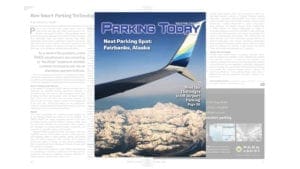
Discover how smart parking systems can provide new data to empower airports to better plan and react to a fluid operating environment.
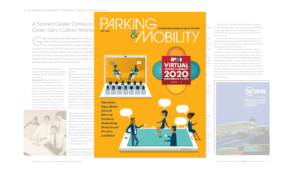
Former Senior Vice President Gary Cudney was interviewed in May’s issue of Parking & Mobility Magazine about his career, his experience in parking, and how the parking industry has changed over the years.
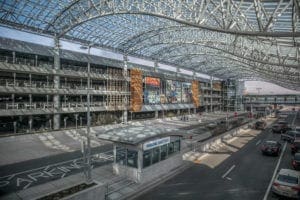
Is your parking system “Smart”? Parking facilities are the first & last impression of customer service. Learn how to maximize efficiency & profitability of your operations when utilizing Smart Parking as you tailor the traveling experience for your customers and make sure that first & last impression is unforgettable.
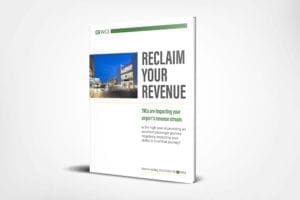
Is the high cost of providing an excellent passenger journey negatively impacting your ability to fund that journey?
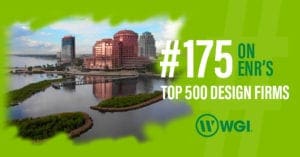
WGI moves up 12 spots on the Engineering News-Record (ENR) 2021 Top 500 Design Firms List!
You’ve been searching for a place like WGI. We look forward to meeting you soon.
Sign up to receive emails to hear our latest news and achievements in our monthly newsletter.
Enter your zip code, and we’ll personalize your experience with local projects, office locations, team members, and more.
WGI supports its associates with meaningful opportunities for growth, strong benefits and perks, while we work collaboratively with clients and co-consultants to shape and improve communities.






WGI is a dynamic organization with opportunities nationwide for engineers, land surveyors, landscape architects, environmental scientists, and architects.